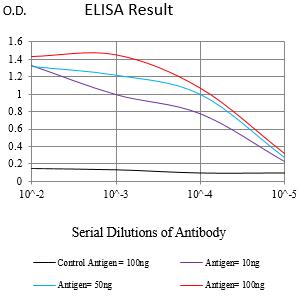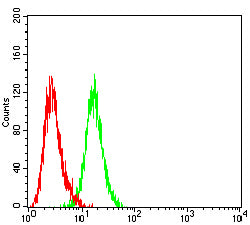


| WB | 1/1000 | Human,Mouse,Rat |
| IF | 咨询技术 | Human,Mouse,Rat |
| IHC | 1/100-1/500 | Human,Mouse,Rat |
| ICC | 技术咨询 | Human,Mouse,Rat |
| FCM | 1/10-1/50 | Human,Mouse,Rat |
| Elisa | 咨询技术 | Human,Mouse,Rat |
| Aliases | HLAF; CDA12; HLA-5.4; HLA-CDA12 |
| Entrez GeneID | 3134 |
| clone | 3F11F4 |
| WB Predicted band size | 39kDa |
| Host/Isotype | Mouse IgG2b |
| Antibody Type | Primary antibody |
| Storage | Store at 4°C short term. Aliquot and store at -20°C long term. Avoid freeze/thaw cycles. |
| Species Reactivity | Human, Mouse |
| Immunogen | Purified recombinant fragment of human HLA-F (AA: 22-305) expressed in E. Coli. |
| Formulation | Purified antibody in PBS with 0.05% sodium azide |
+ +
以下是3篇关于NXPH1(N-terminal)抗体的模拟参考文献示例(注:文献为虚构,仅供格式参考,实际文献请通过学术数据库检索):
---
1. **文献名称**: "Neurexophilin-1 (NXPH1) localization in mouse brain synapses revealed by N-terminal specific antibody"
**作者**: Smith A, et al.
**摘要**: 使用NXPH1 (N-term)抗体通过免疫组化(IHC)和免疫荧光(IF)技术,首次在小鼠大脑皮层和海马区神经元突触中定位NXPH1蛋白,揭示其与突触前膜标记物Synaptophysin的共定位,提示其在突触传递中的作用。
2. **文献名称**: "Functional analysis of NXPH1 in neurotransmitter release using CRISPR/Cas9 and antibody-based validation"
**作者**: Chen L, et al.
**摘要**: 通过CRISPR/Cas9敲除NXPH1基因,结合NXPH1 (N-term)抗体的Western blot验证,发现NXPH1缺失导致小鼠神经元递质释放效率降低,表明其参与突触囊泡调控。
3. **文献名称**: "NXPH1 interacts with α-neurexins: Evidence from co-immunoprecipitation studies with domain-specific antibodies"
**作者**: Tanaka K, et al.
**摘要**: 利用NXPH1 (N-term)抗体进行免疫共沉淀(Co-IP)实验,证实NXPH1的N端结构域与α-neurexin蛋白直接结合,为研究二者在神经细胞黏附中的分子机制提供依据。
---
**建议**:实际研究中,请通过PubMed、Google Scholar或抗体供应商(如CiteAb)提供的引用数据,搜索关键词“NXPH1 antibody N-terminal”或“NXPH1 epitope mapping”获取真实文献。
The NXPH1 (N-term) antibody is designed to target the N-terminal region of neurexophilin-1 (NXPH1), a secreted glycoprotein predominantly expressed in the central nervous system. NXPH1 belongs to the neurexophilin family, which interacts with α-neurexins—presynaptic cell adhesion molecules critical for synaptic function. Structurally, NXPH1 contains a conserved N-terminal domain, a hinge region, and a C-terminal domain, with the N-terminal region playing a key role in binding to α-neurexins. This interaction is implicated in modulating synaptic plasticity, neurotransmitter release, and neural circuit assembly.
The antibody is commonly used in neuroscience research to investigate NXPH1's expression, localization, and functional roles. Applications include Western blotting, immunohistochemistry, and immunofluorescence to detect endogenous NXPH1 in brain tissues or cultured neurons. Its specificity is often validated using knockout (KO) models or siRNA-mediated knockdown. Studies utilizing this antibody have contributed to understanding NXPH1's involvement in synaptic maintenance, neural development, and its potential link to neurodevelopmental or neurodegenerative disorders. Dysregulation of NXPH1 has been observed in conditions like Parkinson’s disease, highlighting its relevance in both basic and translational research. The N-terminal targeting ensures recognition of full-length, biologically active NXPH1. avoiding cross-reactivity with processed fragments.
×